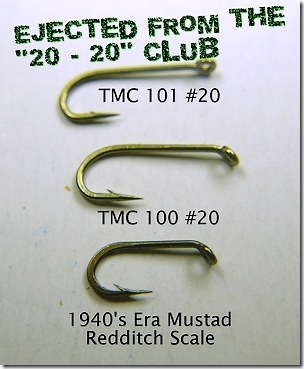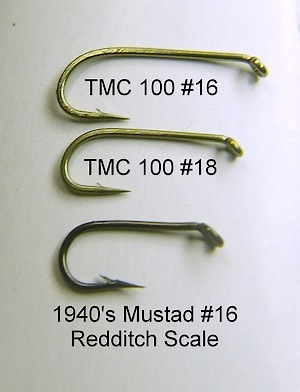 I’m a self confessed collector of hooks and a complete snob. Not that they have to be gilt plated or come from some distant clime, I just need them to be as versatile as screwdrivers and socket wrenches, lots of sizes and similar shapes, but there should be one perfectly suited for the task.
I’m a self confessed collector of hooks and a complete snob. Not that they have to be gilt plated or come from some distant clime, I just need them to be as versatile as screwdrivers and socket wrenches, lots of sizes and similar shapes, but there should be one perfectly suited for the task.
I’m a bit of an omnivore where fish are concerned; flirting with one species them the other, and require a larger selection than the average tier. Not merely sizes, it’s the attributes of the hook that I covet most.
I’m the guy that fishes a #12 for Carp – and have landed them on #16’s, but it’s not a testament of skill so much as using the proper hook for that scale of quarry.
Trying to find an Extra Strong (XS or X-Heavy) or 2XS in trout sizes has been increasingly difficult, despite Mustad’s claim that a S82-3906B is 3X Heavy, it’s not. Now that many of the smaller vendors have been assimilated by the hook-making Borg, I’m dipping into strange bends and stranger points hoping to find replacements for the plethora of styles now vanished. It’s the same for Extra Short, or Nickel plated, and what few new styles crack the fly shop lineup have all been Czech-related or similar specialty.
You’ve endured my high pitched whine in numerous threads…
I’m a snob because I prefer the Redditch hook scale and the size of gapes and shanks that are common to that standard. As Mustad was the fly tying standard for so many years, new companies from China, Korea, and Japan, had to clone their best selling hooks to compete.
![]() Our old favorites, the 94840 (R50-94840 – Dry) and 3906B (S82-3906B – Nymph, Wet) were actually extra long shanked – and used to say as much on the label. Now with the economy packaging and terse descriptions – the 94840 is listed as “standard length” and most tiers are unaware that their #18’s and #16’s share a nearly identical shank length.
Our old favorites, the 94840 (R50-94840 – Dry) and 3906B (S82-3906B – Nymph, Wet) were actually extra long shanked – and used to say as much on the label. Now with the economy packaging and terse descriptions – the 94840 is listed as “standard length” and most tiers are unaware that their #18’s and #16’s share a nearly identical shank length.
![]() Hook makers from Japan have upset Mustad’s domination of the fly hook market, but in doing so they copied the Mustad hooks and preserved the Mustad measurements of gape and shank length, and propagated the differences to Tiemco, Daiichi, Dai-Riki, and all the rest.
Hook makers from Japan have upset Mustad’s domination of the fly hook market, but in doing so they copied the Mustad hooks and preserved the Mustad measurements of gape and shank length, and propagated the differences to Tiemco, Daiichi, Dai-Riki, and all the rest.
… and the differences are readily apparent, as all the hooks below size 16 are disproportionally long shanked.
Slowly we’re sliding back into the Good Old Days, where multiple standards compete and different vendors perpetuate adherence to one or the other, confusing nearly everyone to the point of having to peer at the hook before purchasing.

Which was part of the reason for my excitement when I spied a trove of hooks last week, most were old enough to pre-date the drift off-standard that occurred during the Great Shank Expansion of the 70’s.
… and why I leaped in with both feet.
Now that I’ve restocked all the important sizes and styles (paying just over a dollar a box, complements of eBay), and I’m rolling in them like Scrooge McDuck, and differences between the vintages is quite noticeable.
Considering how far our standard shank has lengthened (above), and realizing that the proportions we teach in fly tying classes and books are all based on the Redditch standard, the dry fly especially is undergoing an evolution.
Extra shank means a longer body, usually fur, and that extra iron are both adding to the weight of the finished fly. Classic books from the turn of the Century describe the (optimal, and yes, fanciful) dry fly riding on the points of the hackle and barbs of the tail – with the hook merely grazing the surface. With the additional length of shank and adherence to proportions, that’s no longer possible even when dry.
… and if Theodore Gordon was in charge of the “20 – 20” club membership, a twenty inch fish taken on a #20 or smaller hook, he’d have them liveried servants toss you out the place.
Those that have learned the craft since the 80’s are going to feel cramped and frustrated. The above photo of the #16’s shows just how much extra real estate you’ve taken for granted.
… and for those learning to tie, consider that age of the book you’re learning from – is that glossy plate from the 40’s or 50’s, and is that the reason your fly looks different or it’s attitude on the table is not the same as yours?
With the disparity in shank length, it’s possible we’re headed into another unsettling period where factions of vendors align themselves into pseudo-standards, with the forums ablaze with opinion.
A good description of the early days of the Fly Hook Wars is available on the fly fishing history site. It’s an interesting read for those afflicted and explains much of what you’ve already encountered and what may result.
Tags: Aberdeen, O’Shaughnessy, Kirby, Kendall, Redditch Standard, O. Mustad & Sons, Tiemco hooks, Dai-Riki hooks, 20-20 club, Theodore Gordon, fly tying materials, fly tying hooks, hook evolution

Yum. Steak for breakfast. Calling bluegills harlots is entertaining; but I truly appreciate “listening” to you discourse on sundry topics like this.
Wow. While I’ve long felt the difference between an 18 and a 16 was primarily in hook gape, I am amazed to see how much the hooks vary from yesteryear to what we young whippersnappers get now.
At some point wouldn’t it be nice if hooks were just given by their measurements?
.030″ wire, .188 Gape, .375 Shank
Leave the words to describe the Up/down/straight eyes, shape, etc…
I’ve been tying flies down to size 22 on “modern” hooks without a second thought and had several “20-20s” last year(or so I thought).
About a month ago, I picked up some old stock Mustad hooks size 18-30 on the cheap. I’d forgotten how tiny a true size 20 is! Now I realize that at best I may have had a few “18-20s” last year. Most likely they were “16-20s”
:>(
Given standard proportions, if you tie a #16 dry fly and a #18, you’ll be really hard pressed to see a difference in size.
Anything #18 and smaller is much more exaggerated of shank than the larger sizes. I’ve always assumed that the 12-14-16 range was the sweet spot for selling hooks – hence the smaller and larger sizes receive much less love.
Pingback: When a great fish hook goes bad | Singlebarbed